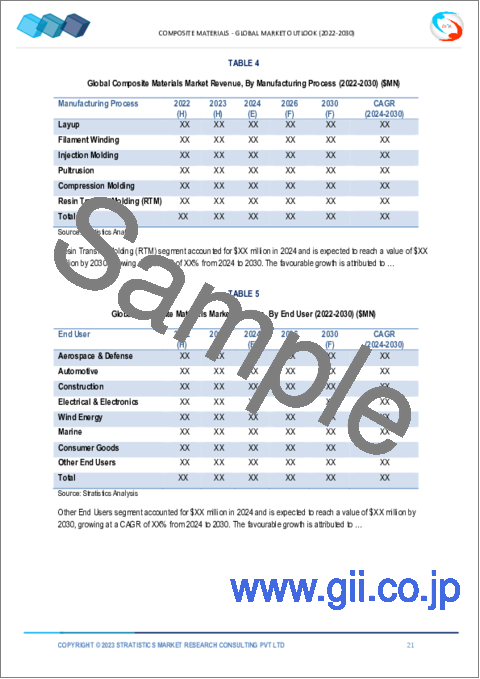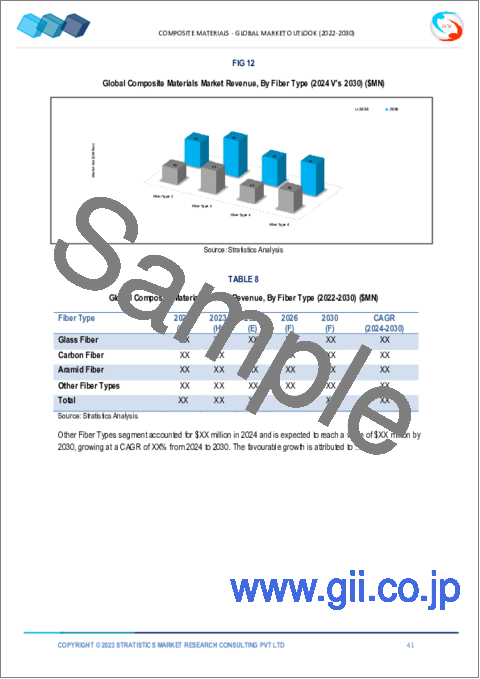|
|
市場調査レポート
商品コード
1530770
複合材料市場の2030年までの予測: タイプ別、樹脂タイプ別、繊維タイプ別、製造プロセス別、エンドユーザー別、地域別の世界分析Composite Materials Market Forecasts to 2030 - Global Analysis By Type (Polymer Matrix Composites, Metal Matrix Composites, Ceramic Matrix Composites and Other Types), Resin Type, Fiber Type, Manufacturing Process, End User and By Geography |
||||||
カスタマイズ可能
|
|||||||
| 複合材料市場の2030年までの予測: タイプ別、樹脂タイプ別、繊維タイプ別、製造プロセス別、エンドユーザー別、地域別の世界分析 |
|
出版日: 2024年08月01日
発行: Stratistics Market Research Consulting
ページ情報: 英文 200+ Pages
納期: 2~3営業日
|
全表示
- 概要
- 図表
- 目次
Stratistics MRCによると、複合材料の世界市場は2024年に1,116億米ドルを占め、予測期間中のCAGRは9.2%で、2030年には1,892億米ドルに達する見込みです。
複合材料は、2つ以上の異なる材料から作られた人工物質であり、それらを組み合わせると、特性が強化された新しい材料ができます。一般的に、複合材料にはマトリックス(樹脂や金属など)と強化繊維(ガラスやカーボンなど)が含まれ、これらが一体となって、個々の部品に比べて優れた強度、耐久性、軽量特性を発揮します。この組み合わせにより、カスタマイズされた性能と機能性を実現できるため、複合材料は航空宇宙、自動車、建設、その他さまざまな産業における用途に理想的な材料となっています。
OICAによると、世界の自動車生産台数は2022年の8,483万台から2023年には9,354万台に増加し、前年比成長率は10.3%です。
高性能材料への需要の増加
技術が進歩し、多くの産業で用途が拡大するにつれて、高性能材料の需要が増加しています。優れた強度、軽量特性、耐久性で知られるこれらの材料は、航空宇宙、自動車、建設などの分野で不可欠です。性能と効率の向上に対するニーズは、持続可能性の重視の高まりと相まって、先端複合材料の採用に拍車をかけており、この分野の市場成長と技術革新を促進しています。
長期耐久性への懸念
航空宇宙、自動車、土木工学など、要求の厳しいさまざまな用途でこれらの材料の利用が増加しているため、市場では長期耐久性が依然として重要な課題となっています。軽量で高強度という利点があるにもかかわらず、複合材料は環境要因による劣化、疲労、機械的損傷といった経年劣化の問題に悩まされることがあります。紫外線、湿気、温度変動はマトリックスを弱め、材料全体の性能を低下させます。
製造技術の進歩
複合材料の製造技術における最近の進歩は、業界に革命をもたらしています。自動繊維配置(AFP)技術の統合は、精度と効率を向上させ、人件費を削減しながら複雑な形状の製造を可能にしました。さらに、3Dプリンティングの進歩は、材料の無駄を最小限に抑えながら複雑な複合材構造を作り出す新たな可能性をもたらしています。これらの技術は、市場の大幅な成長と多様化の原動力となっています。
リサイクルの課題
複合材料のリサイクルは、一般的に繊維や樹脂など複数の材料を組み合わせた複雑な構造のため、大きな課題があります。主な困難は、これらの成分を効率的に分離することにあり、従来のリサイクル方法では、繊維とマトリックスの強い接着に苦戦することが多いです。標準化されたリサイクル・プロトコルやインフラがないことが、さらに成長を妨げています。さらに、複合材料の種類が多様であるため、それぞれに合ったリサイクル・ソリューションが必要となり、複雑さとコストが増大します。
COVID-19の影響:
COVID-19の大流行は市場を大きく混乱させ、製造工程の停止や建設・航空宇宙プロジェクトの遅延による需要の急減につながった。サプライチェーンの中断と労働力の減少が生産課題をさらに悪化させました。しかし、産業界が新たな安全プロトコルに順応し、活動を再開したため、市場は回復の兆しを見せた。医療機器や防護機器向けの軽量で耐久性のある素材への注目が高まったことも、需要の緩やかな回復に寄与しました。
予測期間中、炭素繊維セグメントが最大になる見込み
炭素繊維は予測期間中最大になると予想されます。炭素繊維複合材料は、従来の材料に比べて性能が優れているため、航空宇宙、自動車、スポーツ用具での使用が増加しています。市場を牽引しているのは、燃費を改善し排出ガスを削減する軽量で高強度な素材に対する需要の高まりです。製造プロセスや用途の革新が市場を拡大し、様々な産業分野での採用が増加しています。
予測期間中、フィラメントワインディングセグメントが最も高いCAGRが見込まれる
フィラメントワインディング分野は、予測期間中に最も高いCAGRが見込まれます。フィラメントワインディングは、複合材料市場で高強度軽量構造の製造に使用される技術です。この方法では、繊維をマンドレルに正確なパターンで巻き付け、樹脂を含浸させて硬化させる。優れた機械的特性を持つ複雑な形状を作ることができるため、航空宇宙やスポーツ用品などの産業で広く利用されています。
最大のシェアを占める地域
予測期間中、北米が最大の市場シェアを占めると予測されます。炭素繊維やガラス繊維などの先端複合材料は、その高い強度対重量比と耐久性から採用が増加しています。製造プロセスの革新と持続可能な素材への取り組みが、市場をさらに後押ししています。この地域の確立された製造インフラと技術の進歩も市場の拡大に寄与しています。
CAGRが最も高い地域:
アジア太平洋地域は、燃費効率と性能向上を目的とした軽量素材の採用増加により、予測期間中最も高いCAGRを維持すると予測されます。主な促進要因としては、インフラプロジェクトの増加、自動車の技術革新、再生可能エネルギーソリューションの推進などが挙げられます。研究開発への多額の投資により、この地域は複合材料の生産と応用の主要拠点となりつつあり、世界市場のリーダーとしての地位を確立しつつあります。
無料のカスタマイズサービス:
本レポートをご購読のお客様には、以下の無料カスタマイズオプションのいずれかをご利用いただけます:
- 企業プロファイル
- 追加市場プレイヤーの包括的プロファイリング(3社まで)
- 主要企業のSWOT分析(3社まで)
- 地域セグメンテーション
- 顧客の関心に応じた主要国の市場推計・予測・CAGR(注:フィージビリティチェックによる)
- 競合ベンチマーキング
- 製品ポートフォリオ、地理的プレゼンス、戦略的提携に基づく主要企業のベンチマーキング
目次
第1章 エグゼクティブサマリー
第2章 序文
- 概要
- ステークホルダー
- 調査範囲
- 調査手法
- データマイニング
- データ分析
- データ検証
- 調査アプローチ
- 調査情報源
- 1次調査情報源
- 2次調査情報源
- 前提条件
第3章 市場動向分析
- 促進要因
- 抑制要因
- 機会
- 脅威
- エンドユーザー分析
- 新興市場
- COVID-19の影響
第4章 ポーターのファイブフォース分析
- 供給企業の交渉力
- 買い手の交渉力
- 代替品の脅威
- 新規参入業者の脅威
- 競争企業間の敵対関係
第5章 世界の複合材料市場:タイプ別
- ポリマーマトリックス複合材料(PMC)
- 金属マトリックス複合材料(MMC)
- セラミックマトリックス複合材料(CMC)
- その他のタイプ
第6章 世界の複合材料市場:樹脂タイプ別
- 熱硬化性複合材料
- エポキシ
- ポリエステル
- ビニルエステル
- 熱可塑性複合材料
- ポリプロピレン(PP)
- ポリアミド(PA)
- ポリエーテルエーテルケトン(PEEK)
第7章 世界の複合材料市場:繊維タイプ別
- ガラス繊維
- カーボンファイバー
- アラミド繊維
- その他の繊維タイプ
第8章 世界の複合材料市場:製造プロセス別
- レイアップ
- フィラメントワインディング
- 射出成形
- プルトルージョン
- 圧縮成形
- 樹脂トランスファー成形(RTM)
第9章 世界の複合材料市場:エンドユーザー別
- 航空宇宙・防衛
- 自動車
- 建設
- 電気・電子
- 風力エネルギー
- 海洋
- 消費財
- その他のエンドユーザー
第10章 世界の複合材料市場:地域別
- 北米
- 米国
- カナダ
- メキシコ
- 欧州
- ドイツ
- 英国
- イタリア
- フランス
- スペイン
- その他欧州
- アジア太平洋
- 日本
- 中国
- インド
- オーストラリア
- ニュージーランド
- 韓国
- その他アジア太平洋地域
- 南米
- アルゼンチン
- ブラジル
- チリ
- その他南米
- 中東・アフリカ
- サウジアラビア
- アラブ首長国連邦
- カタール
- 南アフリカ
- その他中東とアフリカ
第11章 主な発展
- 契約、パートナーシップ、コラボレーション、合弁事業
- 買収と合併
- 新製品発売
- 事業拡大
- その他の主要戦略
第12章 企業プロファイリング
- Toray Industries, Inc.
- Teijin Limited
- Hexcel Corporation
- SGL Carbon SE
- DSM N.V.
- Mitsubishi Chemical Corporation
- Solvay
- Cytec Industries Inc.
- Huntsman Corporation
- DuPont
- Weyerhaeuser Company
- Zoltek Companies, Inc.
- Lanxess AG
- 3A Composites
- Hexagon Composites ASA
- Celanese Corporation
- Plasan Carbon Composites
- Rockwood Composites
- Owens Corning
List of Tables
- Table 1 Global Composite Materials Market Outlook, By Region (2022-2030) ($MN)
- Table 2 Global Composite Materials Market Outlook, By Type (2022-2030) ($MN)
- Table 3 Global Composite Materials Market Outlook, By Polymer Matrix Composites (PMCs) (2022-2030) ($MN)
- Table 4 Global Composite Materials Market Outlook, By Metal Matrix Composites (MMCs) (2022-2030) ($MN)
- Table 5 Global Composite Materials Market Outlook, By Ceramic Matrix Composites (CMCs) (2022-2030) ($MN)
- Table 6 Global Composite Materials Market Outlook, By Other Types (2022-2030) ($MN)
- Table 7 Global Composite Materials Market Outlook, By Resin Type (2022-2030) ($MN)
- Table 8 Global Composite Materials Market Outlook, By Thermoset Composites (2022-2030) ($MN)
- Table 9 Global Composite Materials Market Outlook, By Epoxy (2022-2030) ($MN)
- Table 10 Global Composite Materials Market Outlook, By Polyester (2022-2030) ($MN)
- Table 11 Global Composite Materials Market Outlook, By Vinyl Ester (2022-2030) ($MN)
- Table 12 Global Composite Materials Market Outlook, By Thermoplastic Composites (2022-2030) ($MN)
- Table 13 Global Composite Materials Market Outlook, By Polypropylene (PP) (2022-2030) ($MN)
- Table 14 Global Composite Materials Market Outlook, By Polyamide (PA) (2022-2030) ($MN)
- Table 15 Global Composite Materials Market Outlook, By Polyetheretherketone (PEEK) (2022-2030) ($MN)
- Table 16 Global Composite Materials Market Outlook, By Fiber Type (2022-2030) ($MN)
- Table 17 Global Composite Materials Market Outlook, By Glass Fiber (2022-2030) ($MN)
- Table 18 Global Composite Materials Market Outlook, By Carbon Fiber (2022-2030) ($MN)
- Table 19 Global Composite Materials Market Outlook, By Aramid Fiber (2022-2030) ($MN)
- Table 20 Global Composite Materials Market Outlook, By Other Fiber Types (2022-2030) ($MN)
- Table 21 Global Composite Materials Market Outlook, By Manufacturing Process (2022-2030) ($MN)
- Table 22 Global Composite Materials Market Outlook, By Layup (2022-2030) ($MN)
- Table 23 Global Composite Materials Market Outlook, By Filament Winding (2022-2030) ($MN)
- Table 24 Global Composite Materials Market Outlook, By Injection Molding (2022-2030) ($MN)
- Table 25 Global Composite Materials Market Outlook, By Pultrusion (2022-2030) ($MN)
- Table 26 Global Composite Materials Market Outlook, By Compression Molding (2022-2030) ($MN)
- Table 27 Global Composite Materials Market Outlook, By Resin Transfer Molding (RTM) (2022-2030) ($MN)
- Table 28 Global Composite Materials Market Outlook, By End User (2022-2030) ($MN)
- Table 29 Global Composite Materials Market Outlook, By Aerospace & Defense (2022-2030) ($MN)
- Table 30 Global Composite Materials Market Outlook, By Automotive (2022-2030) ($MN)
- Table 31 Global Composite Materials Market Outlook, By Construction (2022-2030) ($MN)
- Table 32 Global Composite Materials Market Outlook, By Electrical & Electronics (2022-2030) ($MN)
- Table 33 Global Composite Materials Market Outlook, By Wind Energy (2022-2030) ($MN)
- Table 34 Global Composite Materials Market Outlook, By Marine (2022-2030) ($MN)
- Table 35 Global Composite Materials Market Outlook, By Consumer Goods (2022-2030) ($MN)
- Table 36 Global Composite Materials Market Outlook, By Other End Users (2022-2030) ($MN)
Note: Tables for North America, Europe, APAC, South America, and Middle East & Africa Regions are also represented in the same manner as above.
According to Stratistics MRC, the Global Composite Materials Market is accounted for $111.6 billion in 2024 and is expected to reach $189.2 billion by 2030 growing at a CAGR of 9.2% during the forecast period. Composite materials are engineered substances made from two or more distinct materials that, when combined, create a new material with enhanced properties. Typically, a composite material includes a matrix (such as a resin or metal) and reinforcing fibers (like glass or carbon) that work together to provide superior strength, durability, and lightweight characteristics compared to individual components. This combination allows for customized performance and functionality, making composites ideal for applications in aerospace, automotive, construction, and various other industries.
According to OICA, global automotive production increased from 84.83 million units in 2022 to 93.54 million units in 2023 with a y-o-y growth of 10.3%.
Market Dynamics:
Driver:
Increasing demand for high-performance materials
Demand for high-performance materials is increasing as technology advances and applications across numerous industries growth. These materials, known for their superior strength, lightweight properties, and durability, are essential in sectors such as aerospace, automotive, and construction. The need for enhanced performance and efficiency, coupled with the growing emphasis on sustainability, is fueling the adoption of advanced composites, driving market growth and innovation in the field.
Restraint:
Long-term durability concerns
Long-term durability remains a significant challenge in the market, as these materials are increasingly utilized in various demanding applications such as aerospace, automotive, and civil engineering. Despite their lightweight and high-strength advantages, composites can suffer from issues like degradation due to environmental factors, fatigue, and mechanical damage over time. UV radiation, moisture, and temperature fluctuations can weaken the matrix and reduce overall material performance.
Opportunity:
Advancements in manufacturing technologies
Recent advancements in manufacturing technologies for composite materials are revolutionizing the industry. The integration of automated fiber placement (AFP) technologies has enhanced precision and efficiency, enabling the production of complex geometries with reduced labor costs. Additionally, advancements in 3D printing have introduced new possibilities for creating intricate composite structures with minimized material waste. These technologies are driving significant growth and diversification in the market.
Threat:
Recycling challenges
Recycling composite materials presents significant challenges due to their complex structure, which typically combines multiple materials such as fibers and resins. The primary difficulty lies in separating these components effectively, traditional recycling methods often struggle with the strong adhesion between fibers and matrices. The lack of standardized recycling protocols and infrastructure further impedes growth. Furthermore, the diversity of composite types necessitates tailored recycling solutions, increasing complexity and costs.
Covid-19 Impact:
The COVID-19 pandemic significantly disrupted the market, leading to a sharp decline in demand due to halted manufacturing processes and delays in construction and aerospace projects. Supply chain interruptions and reduced workforce availability further exacerbated production challenges. However, the market showed signs of recovery as industries adapted to new safety protocols and resumed activities. Increased focus on lightweight, durable materials for medical and protective equipment also contributed to a gradual rebound in demand.
The carbon fiber segment is expected to be the largest during the forecast period
The carbon fiber is expected to be the largest during the forecast period. Carbon fiber composites are increasingly used in aerospace, automotive, and sports equipment due to their superior performance compared to traditional materials. The market is driven by rising demand for lightweight, high-strength materials that improve fuel efficiency and reduce emissions. Innovations in manufacturing processes and applications are expanding the market, with increased adoption in various industrial sectors.
The filament winding segment is expected to have the highest CAGR during the forecast period
The filament winding segment is expected to have the highest CAGR during the forecast period. Filament winding is a technique used in the composite materials market for producing high-strength, lightweight structures. This method involves wrapping fibers around a mandrel in a precise pattern, which are then impregnated with resin and cured. It's widely utilized in industries such as aerospace and sports equipment due to its ability to create complex shapes with excellent mechanical properties.
Region with largest share:
North America is projected to hold the largest market share during the forecast period. Advanced composites, such as carbon fiber and fiberglass, are being increasingly adopted for their high strength-to-weight ratio and durability. Innovations in manufacturing processes and the push for sustainable materials further propel the market. The region's well-established manufacturing infrastructure and technological advancements also contribute to the market's expansion.
Region with highest CAGR:
Asia Pacific is projected to hold the highest CAGR over the forecast period driven by rising adoption of lightweight materials for fuel efficiency and performance improvement. Key drivers include the rise in infrastructure projects, automotive innovations, and the push for renewable energy solutions. With significant investments in research and development, the region is becoming a major hub for composite material production and application, positioning itself as a leader in the global market.
Key players in the market
Some of the key players in Composite Materials market include Toray Industries, Inc., Teijin Limited, Hexcel Corporation, SGL Carbon SE, DSM N.V., Mitsubishi Chemical Corporation, Solvay, Cytec Industries Inc., Huntsman Corporation, DuPont, Weyerhaeuser Company, Zoltek Companies, Inc., Lanxess AG, 3A Composites, Hexagon Composites ASA, Celanese Corporation, Plasan Carbon Composites, Rockwood Composites and Owens Corning.
Key Developments:
In February 2024, Owens Corning acquired USD 3.9 billion of Masonite. This acquisition would strengthen the company's position in building and construction materials and the glass reinforcement business within its Composites segment.
In June 2023, Solvay is collaborating with Spirit AeroSystems. Both companies will engage in composite development. This merger would lead to collaborative research into sustainable aircraft technologies and processes with Spirit's industrial, academic, and supply-chain partners.
Types Covered:
- Polymer Matrix Composites (PMCs)
- Metal Matrix Composites (MMCs)
- Ceramic Matrix Composites (CMCs)
- Other Types
Resin Types Covered:
- Thermoset Composites
- Thermoplastic Composites
Fiber Types Covered:
- Glass Fiber
- Carbon Fiber
- Aramid Fiber
- Other Fiber Types
Manufacturing Processes Covered:
- Layup
- Filament Winding
- Injection Molding
- Pultrusion
- Compression Molding
- Resin Transfer Molding (RTM)
End Users Covered:
- Aerospace & Defense
- Automotive
- Construction
- Electrical & Electronics
- Wind Energy
- Marine
- Consumer Goods
- Other End Users
Regions Covered:
- North America
- US
- Canada
- Mexico
- Europe
- Germany
- UK
- Italy
- France
- Spain
- Rest of Europe
- Asia Pacific
- Japan
- China
- India
- Australia
- New Zealand
- South Korea
- Rest of Asia Pacific
- South America
- Argentina
- Brazil
- Chile
- Rest of South America
- Middle East & Africa
- Saudi Arabia
- UAE
- Qatar
- South Africa
- Rest of Middle East & Africa
What our report offers:
- Market share assessments for the regional and country-level segments
- Strategic recommendations for the new entrants
- Covers Market data for the years 2022, 2023, 2024, 2026, and 2030
- Market Trends (Drivers, Constraints, Opportunities, Threats, Challenges, Investment Opportunities, and recommendations)
- Strategic recommendations in key business segments based on the market estimations
- Competitive landscaping mapping the key common trends
- Company profiling with detailed strategies, financials, and recent developments
- Supply chain trends mapping the latest technological advancements
Free Customization Offerings:
All the customers of this report will be entitled to receive one of the following free customization options:
- Company Profiling
- Comprehensive profiling of additional market players (up to 3)
- SWOT Analysis of key players (up to 3)
- Regional Segmentation
- Market estimations, Forecasts and CAGR of any prominent country as per the client's interest (Note: Depends on feasibility check)
- Competitive Benchmarking
- Benchmarking of key players based on product portfolio, geographical presence, and strategic alliances
Table of Contents
1 Executive Summary
2 Preface
- 2.1 Abstract
- 2.2 Stake Holders
- 2.3 Research Scope
- 2.4 Research Methodology
- 2.4.1 Data Mining
- 2.4.2 Data Analysis
- 2.4.3 Data Validation
- 2.4.4 Research Approach
- 2.5 Research Sources
- 2.5.1 Primary Research Sources
- 2.5.2 Secondary Research Sources
- 2.5.3 Assumptions
3 Market Trend Analysis
- 3.1 Introduction
- 3.2 Drivers
- 3.3 Restraints
- 3.4 Opportunities
- 3.5 Threats
- 3.6 End User Analysis
- 3.7 Emerging Markets
- 3.8 Impact of Covid-19
4 Porters Five Force Analysis
- 4.1 Bargaining power of suppliers
- 4.2 Bargaining power of buyers
- 4.3 Threat of substitutes
- 4.4 Threat of new entrants
- 4.5 Competitive rivalry
5 Global Composite Materials Market, By Type
- 5.1 Introduction
- 5.2 Polymer Matrix Composites (PMCs)
- 5.3 Metal Matrix Composites (MMCs)
- 5.4 Ceramic Matrix Composites (CMCs)
- 5.5 Other Types
6 Global Composite Materials Market, By Resin Type
- 6.1 Introduction
- 6.2 Thermoset Composites
- 6.2.1 Epoxy
- 6.2.2 Polyester
- 6.2.3 Vinyl Ester
- 6.3 Thermoplastic Composites
- 6.3.1 Polypropylene (PP)
- 6.3.2 Polyamide (PA)
- 6.3.3 Polyetheretherketone (PEEK)
7 Global Composite Materials Market, By Fiber Type
- 7.1 Introduction
- 7.2 Glass Fiber
- 7.3 Carbon Fiber
- 7.4 Aramid Fiber
- 7.5 Other Fiber Types
8 Global Composite Materials Market, By Manufacturing Process
- 8.1 Introduction
- 8.2 Layup
- 8.3 Filament Winding
- 8.4 Injection Molding
- 8.5 Pultrusion
- 8.6 Compression Molding
- 8.7 Resin Transfer Molding (RTM)
9 Global Composite Materials Market, By End User
- 9.1 Introduction
- 9.2 Aerospace & Defense
- 9.3 Automotive
- 9.4 Construction
- 9.5 Electrical & Electronics
- 9.6 Wind Energy
- 9.7 Marine
- 9.8 Consumer Goods
- 9.9 Other End Users
10 Global Composite Materials Market, By Geography
- 10.1 Introduction
- 10.2 North America
- 10.2.1 US
- 10.2.2 Canada
- 10.2.3 Mexico
- 10.3 Europe
- 10.3.1 Germany
- 10.3.2 UK
- 10.3.3 Italy
- 10.3.4 France
- 10.3.5 Spain
- 10.3.6 Rest of Europe
- 10.4 Asia Pacific
- 10.4.1 Japan
- 10.4.2 China
- 10.4.3 India
- 10.4.4 Australia
- 10.4.5 New Zealand
- 10.4.6 South Korea
- 10.4.7 Rest of Asia Pacific
- 10.5 South America
- 10.5.1 Argentina
- 10.5.2 Brazil
- 10.5.3 Chile
- 10.5.4 Rest of South America
- 10.6 Middle East & Africa
- 10.6.1 Saudi Arabia
- 10.6.2 UAE
- 10.6.3 Qatar
- 10.6.4 South Africa
- 10.6.5 Rest of Middle East & Africa
11 Key Developments
- 11.1 Agreements, Partnerships, Collaborations and Joint Ventures
- 11.2 Acquisitions & Mergers
- 11.3 New Product Launch
- 11.4 Expansions
- 11.5 Other Key Strategies
12 Company Profiling
- 12.1 Toray Industries, Inc.
- 12.2 Teijin Limited
- 12.3 Hexcel Corporation
- 12.4 SGL Carbon SE
- 12.5 DSM N.V.
- 12.6 Mitsubishi Chemical Corporation
- 12.7 Solvay
- 12.8 Cytec Industries Inc.
- 12.9 Huntsman Corporation
- 12.10 DuPont
- 12.11 Weyerhaeuser Company
- 12.12 Zoltek Companies, Inc.
- 12.13 Lanxess AG
- 12.14 3A Composites
- 12.15 Hexagon Composites ASA
- 12.16 Celanese Corporation
- 12.17 Plasan Carbon Composites
- 12.18 Rockwood Composites
- 12.19 Owens Corning





